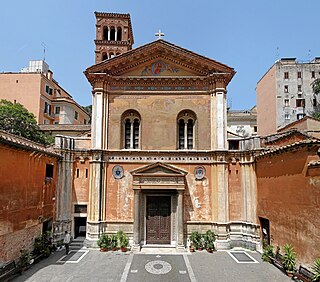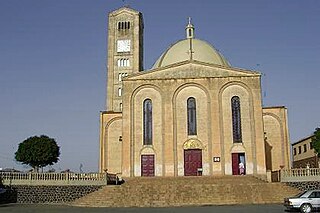
Pius I was the bishop of Rome from c. 140 to his death c. 154, according to the Annuario Pontificio. His dates are listed as 142 or 146 to 157 or 161, respectively. He is considered to have opposed both the Valentinians and Gnostics during his papacy. He is considered a saint by the Catholic Church with a feast day in 11 July, but it is unclear if he died as a martyr.

The Solemnity of the Immaculate Conception celebrates the Immaculate Conception of the Blessed Virgin Mary on 8 December, nine months before the feast of the Nativity of Mary on 8 September. It is one of the most important Marian feasts in the liturgical calendar of the Latin Church.

May 18 - Eastern Orthodox Church calendar - May 20

Our Lady of Aparecida, is a title of the Blessed Virgin Mary associated with the Immaculate Conception.

The Basilica of Saint Praxedes, commonly known in Italian as Santa Prassede, is an early medieval titular church and minor basilica located near the papal basilica of Saint Mary Major, on Via di Santa Prassede, rione Monti in Rome, Italy. The current Cardinal Priest of Titulus Sancta Praxedis is Paul Poupard.

The Basilica of Santa Pudenziana is the eldest historical Roman Catholic basilica built in the fourth century. The original shrine building dates back from the second century and is dedicated to Saint Pudentiana, sister to Praxedes the Martyress and both daughters of Saint Pudens. It is one of the national churches in Rome designated for the Philippines and is both piously and culturally associated with the Filipino peoples. It is designated a Basilica by the privilege of immemorial status.

Pudens was an early Christian saint and martyr. He is mentioned as a layman of the Roman Church in 2 Timothy 4:21.

Saint Praxedes, called "a Roman maiden", was a saint and virgin who lived in the Roman Empire during the 2nd century. Along with her sister, Saint Pudentiana, she provided for the poor and gave care and comfort to persecuted Christians and martyrs. Her veneration began in the 4th century and many churches have been dedicated to her.

The Archdiocese of Cebu is a Latin Church archdiocese of the Catholic Church in the Philippines and one of the ecclesiastical provinces of the Catholic Church in the country. It is composed of the entire civil province of Cebu. The jurisdiction, Cebu, is considered as the fount of Christianity in the Far East.
This article lists the feast days of the General Roman Calendar as approved on 25 July 1960 by Pope John XXIII's motu proprioRubricarum instructum and promulgated by the Sacred Congregation of Rites the following day, 26 July 1960, by the decree Novum rubricarum. This 1960 calendar was incorporated into the 1962 edition of the Roman Missal, continued use of which Pope Benedict XVI authorized in his 7 July 2007 motu proprio Summorum Pontificum, and which Pope Francis updated in his 16 July 2021 motu proprio Traditionis custodes, for use as a Traditional Roman Mass.

The Minor Basilica and Metropolitan Cathedral of the Immaculate Conception, commonly known as the Manila Cathedral, is a Roman Catholic basilica and cathedral church of the Archdiocese of Manila. It is dedicated to the Blessed Virgin Mary of the Immaculate Conception, the principal Patroness of the Philippines.

The Mariology of the popes is the theological study of the influence that the popes have had on the development, formulation and transformation of the Roman Catholic Church's doctrines and devotions relating to the Blessed Virgin Mary.

Mary, Help of Christians is a Catholic title of the Blessed Virgin Mary, based on a devotion now associated with a feast day of the General Roman Calendar on 24 May. The Catholic saint, John Chrysostom was the first person to use this Marian title in year 345 A.D. Don Bosco also propagated the same devotion Mary, Help of Christians. It is also associated with the defense of Christian Europe, the north of Africa and the Middle East from non-Christian peoples during the Middle Ages.
Mysterii Paschalis is an apostolic letter issued motu proprio by Pope Paul VI on 14 February 1969. It reorganized the liturgical year of the Roman Rite and revised the liturgical celebrations of Jesus Christ and the saints in the General Roman Calendar. It promulgated the General Roman Calendar of 1969.

Saint Potenciana was a Spanish anchoress, possibly of the walled-in type, who died probably in the 16th century and who is venerated locally as a saint. She has not been formally canonized and is not listed in the Roman Martyrology.

The Apostolic Vicariate of Puerto Princesa is a Latin Church missionary jurisdiction or apostolic vicariate of the Catholic Church located in the Province of Palawan, Philippines. Its cathedra is within Immaculate Conception Cathedral in the episcopal see of Puerto Princesa City, Palawan, Philippines. It is not a part of an ecclesiastical province as it is directly exempt to the Holy See, specifically the Congregation for the Evangelization of Peoples, yet for the purpose of apostolic cooperation usually grouped with the Ecclesiastical Province of Manila, along with the Roman Catholic Apostolic Vicariate of Taytay. The current Vicar Apostolic is Bishop Socrates Calamba Mesiona.

The Our Lady of Guidance is a title of the Blessed Virgin Mary associated with a 16th-century Marian image depicted as the Immaculate Conception and widely venerated by Filipinos. The wooden Black Madonna is considered the oldest extant Marian statue in the Philippines. Locally venerated as patroness of navigators and travelers, the image is enshrined at the Ermita Church in the city of Manila.

In the Catholic Church, several locations around the world invoke the patronage of the Immaculate Conception. Catholic diocesan authorities with the expressed and written approval of the Pope in countries including the United States, Brazil, Korea, the Philippines and Spain designate the Blessed Virgin Mary as their principal patroness.

The Eritrean Catholic Archeparchy of Asmara, officially the Archeparchy of Asmara, more informally Asmara of the Eritreans, is the metropolitan see of the Eritrean Catholic Church, a sui iuris Eastern Catholic Church whose territory corresponds to that of the State of Eritrea in the Horn of Africa. It depends on the Roman Congregation for the Oriental Churches.

Our Lady of Arabia is a Catholic title of the Blessed Virgin Mary holding a Rosary and the Child Jesus, as venerated in Kuwait and Bahrain by its faithful devotees. Under this venerated Marian title, she is designated as the patroness of the Apostolic Vicariates of Northern and Southern Arabia.




















